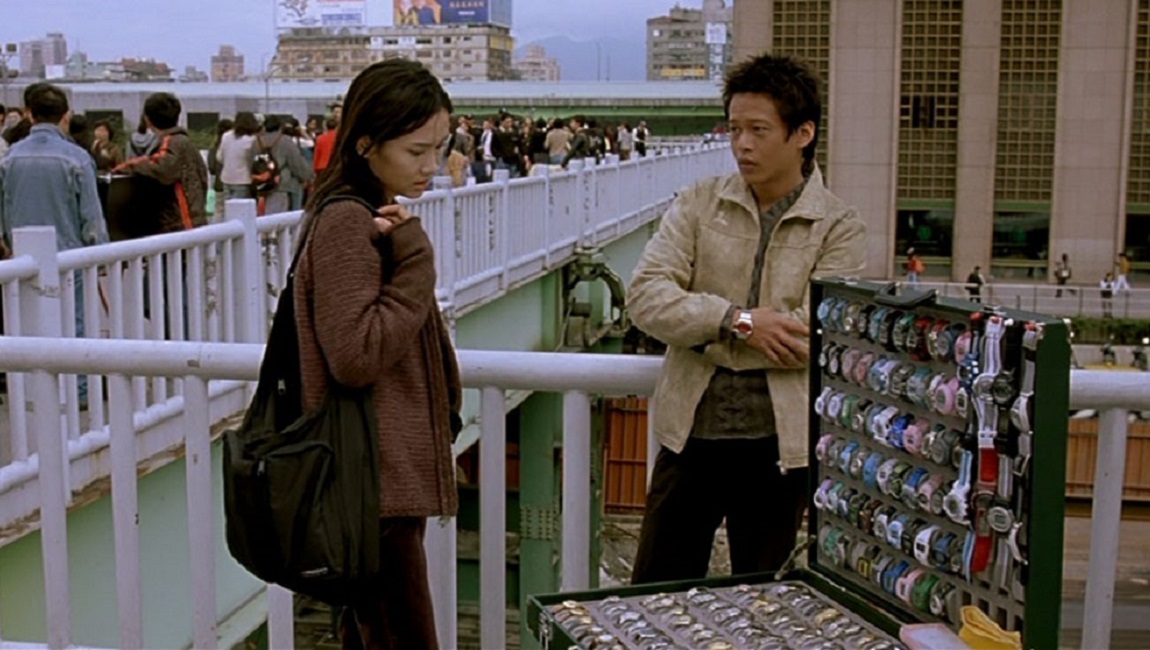Abbas Kiarostami has mostly stayed away from love stories—he tends to find it impossible in his films to recreate situations that even remotely hint at intimacy, his art being so closely monitored by authorities whose conservative religious values disallow any such representation. Through the Olive Trees is the closest we get to lust and young love in Kiarostami’s oeuvre, but its erotic power is frequently overlooked by Western critics—it has to be subtle. The film immediately distinguishes itself as being something different from the previous two entries in Kiarostami’s Koker trilogy; it presents a new director stand-in, a character seen at the start of the film recruiting Koker actors to perform in his next production. As in Life, and Nothing More… there are references to previous Koker trilogy installments—the two young boys from Where Is the Friend’s Home? that the director in Life was searching for—but our attention is always on the troubled relations between the two young actors recruited for this new project, Hossein and Tahareh.
Apparently based on actual events that occurred while Kiarostami was filming Life, Olive Trees follows the relentless romantic pursuits of Hossein, a poor, illiterate construction worker, as he attempts to earn the beautiful Tahareh’s hand in marriage. While it appears Tahareh is giving him the silent treatment throughout most of the film, this is not representative of her own feelings but rather due to the conduct Islamic women are beholden to. As noted by Hossein, when the director tries to recruit a peasant girl, women in this part of the country are not allowed to look, let alone speak, to male strangers. Kiarostami gives this cue to the audience in order to understand Tahareh’s supposed cold reaction to Hossein—she is not indifferent to Hossein’s pleas, but must remain silent due to the cultural restrictions imposed on her.
Hossein is one of the most affable Kiarostami archetypes—as stubborn as he is sincere, aware his class prevents him from marrying “up” but refuting the logic of tradition. After being denied Tahareh’s hand by her grandmother, Hossein expresses such a utopian view of the broader implications of his pursuit of Tahareh that one can’t help but sincerely wish the world did work as he says it should. According to Hossein, literates should marry illiterates, the rich should marry the poor, homeowners should marry those without property to their name—that way, we can help one another. As Hossein posits, why would a couple need two houses? It makes more sense to share what we all have instead of selfishly capitalizing on resources for our own use. But the latter is exactly what homeowners do, the director argues back, rich married couples would often live in one of their houses and rent out the other. Hossein does not have an answer to this.
As in Life, and Nothing More… there are references to previous Koker trilogy installments, but our attention is always on the troubled relations between the two young actors recruited for this new project.
Kiarostami understands that social rules prevent a real-life Hossein and Tahareh from ever becoming involved, but he indulges an enjoyably transgressive ending anyway, one in which Hossein follows Tahareh up the same zigzag path traversed by Ahmad in Where Is the Friend’s Home? Upon reaching the top of the hill, Hossein sees Tahareh disappear through a grove of olive trees, and Kiarostami follows him to see what happens. The camera remains static as Hossein runs down the other side of the hill, through the olive trees and into an expansive meadow. As the two characters become indistinguishable dots disappearing into the distance, both suddenly stop. Hossein then turns around and hurries back up the path, presumably having been given a positive response from Tahareh. As some scholars have noted, the only way it could have been possible for Kiarostami to film a positive interaction between the couple would have been for them to become tiny dots, and as in Friend’s House, we see Kiarostami relying on the abstraction of reality to make a larger point—in this case, the realization of a romantic ending in a culture that refutes premarital longing.
That Kiarostami does not follow Hossein up the zigzaging path of olive tress, and that there is another, similar path running along the other side of the hill, gives the sense that the final scene of Through the Olive Trees throws Hossein and Tahareh into a parallel universe, visible only to them and the viewer, one in which—despite being represented by mere dots—they are finally free to love one another without patriarchal rules thwarting their yearning. For most of the film, Olive Trees gives the impression of being the weakest of the Koker trilogy—especially due to its quaint reliance on meta-narrative references to previous films—but the ending compensates, perhaps enough to make it the most poignant of the three works. It would take more than a decade for Kiarostami to revisit overtly romantic themes in his work, and the brilliance of Certified Copy, along with this film, suggests that there is much potential to be found in a Kiarostami love story.







